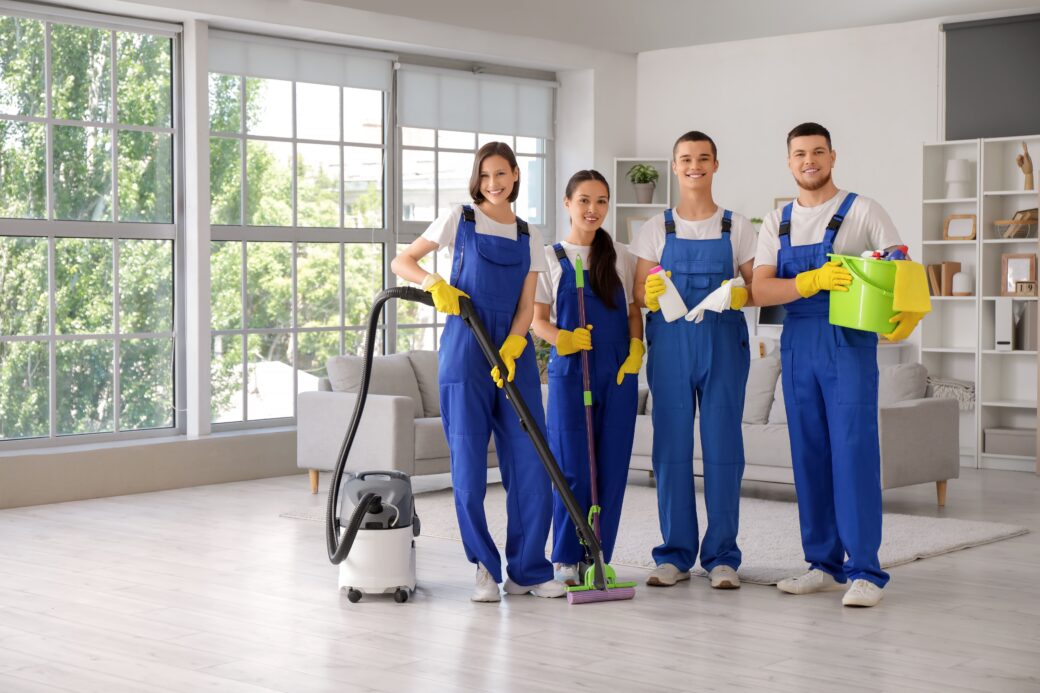Professional office cleaners follow a systematic approach to ensure that office spaces are thoroughly cleaned and maintained.
Here’s an outline of how they typically clean offices…
Preparation
- Gathering Supplies – Cleaners begin by gathering all necessary cleaning supplies, such as vacuum cleaners, mops, dusting cloths, cleaning chemicals, and disinfectants.
- Personal Protective Equipment (PPE) – They may wear gloves, masks, and other protective gear to ensure safety while cleaning.
Dusting and Wiping Surfaces
- Dusting – Cleaners start by dusting all surfaces, including desks, shelves, light fixtures, windowsills, and baseboards, using microfiber cloths or dusters.
- Disinfecting High-Touch Areas – High-touch surfaces such as doorknobs, light switches, keyboards, telephones, and printer buttons are wiped down with disinfectant wipes or sprays to reduce germs.
Cleaning Floors
- Vacuuming – All carpeted areas are vacuumed thoroughly, including under desks and in hard-to-reach spots.
- Mopping – For non-carpeted areas like tile or hardwood, floors are swept and mopped to remove dirt and stains.
Cleaning Restrooms
- Toilets and Sinks – Cleaners disinfect and sanitize toilets, sinks, and countertops, making sure to clean inside and around the toilet bowl.
- Mirrors – Mirrors are wiped to remove streaks and watermarks.
- Restocking Supplies – Paper towels, toilet paper, and soap are restocked as necessary.
Emptying Trash and Recycling Bins
- Trash Removal – Cleaners empty trash cans and replace liners. This includes both general waste and recycling bins, ensuring proper disposal of office waste.
Kitchen or Break Room
- Cleaning Surfaces – Cleaners wipe down countertops, tables, and kitchen appliances like the microwave, fridge, and coffee maker.
- Dishwashing – If required, cleaners may wash dishes or ensure that dirty dishes are placed in the dishwasher.
Special Areas (if applicable)
- Windows – Cleaners may wash windows or glass surfaces to remove fingerprints and smudges.
- Carpet or Upholstery Cleaning – Professional cleaners may perform spot cleaning or deep cleaning of carpets or office furniture if needed.
Final Touches
- Organizing – In some cases, cleaners may help with minor tidying up, like straightening up chairs or arranging magazines or brochures in waiting areas.
- Odor Control – They may use air fresheners or air purifiers to leave the office smelling fresh.
Safety and Disinfection
- High-Traffic Areas – Cleaners focus extra attention on high-traffic areas where germs and bacteria are more likely to accumulate, ensuring a healthier environment for employees.
Conclusion
- Efficiency – Professional cleaners work efficiently, following a detailed routine to ensure that no area is overlooked.
- Consistency – They aim to deliver a consistently clean, fresh, and sanitized office space, which contributes to a productive and healthy work environment.

Leave a Comment